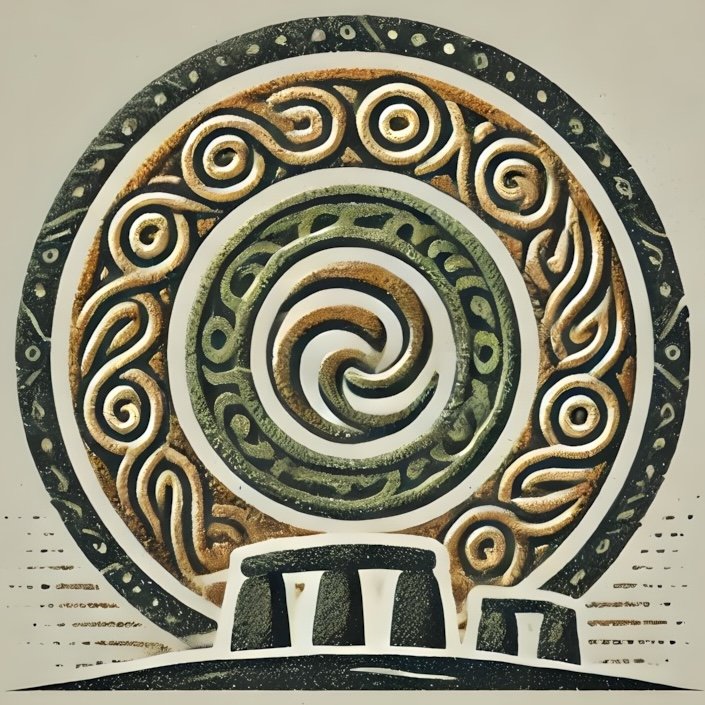Introduction to the Tuatha Dé Danann
In Irish mythology, the Tuatha Dé Danann stand out as one of the most captivating and enigmatic groups. Often referred to as the “People of the Goddess Danu,” they are depicted as a race of supernatural beings who possessed immense power and wisdom. According to myth, they arrived in Ireland from the mystical land of the West, bringing with them advanced knowledge of arts, crafts, and magic. The Tuatha Dé Danann are not merely mythological figures; they embody the spiritual and cultural ethos of ancient Ireland, representing the intersection of the natural and supernatural worlds.
The Tuatha Dé Danann are often associated with various sacred sites, particularly the mounds that dot the Irish landscape. These sites, steeped in history and legend, serve as a tangible connection to the past, inviting exploration into the lives and beliefs of these ancient beings.
The Sacred Mounds in Irish Prehistory
The sacred mounds of Ireland, known as “síde” or “sídhe,” are monumental earthworks that have captivated the imagination of historians and archaeologists alike. Dating back to the Neolithic period, these structures are often linked to burial practices, ceremonial activities, and the veneration of the ancestors. The most famous of these mounds include the Hill of Tara, Newgrange, and the Loughcrew Cairns, each holding its own unique significance in the landscape of Irish prehistory.
These mounds were not simply burial sites; they were also places of worship and community gathering. The alignment of many of these structures with celestial events, such as solstices and equinoxes, suggests that they were integral to the spiritual lives of the people who built them. The sacred mounds are not only physical remnants of ancient societies but also gateways to understanding their beliefs and practices.
Connections Between the Tuatha Dé Danann and Sacred Sites
The Tuatha Dé Danann are inextricably linked to the sacred mounds that pepper the Irish landscape. According to myth, these mounds were seen as the dwelling places of the Tuatha Dé Danann, where they retreated from the mortal world. The belief that these mounds were entrances to the Otherworld—a realm inhabited by gods, spirits, and ancestors—highlights their significance in both mythology and ritual practice.
Sites like the Hill of Tara are often cited as the political and spiritual epicenter of ancient Ireland, where the Tuatha Dé Danann were believed to have held court. The landscape itself is imbued with stories of battles, alliances, and divine interventions, creating a rich narrative that intertwines the history of the land with the mythology of its people.
Key Figures of the Tuatha Dé Danann
The Tuatha Dé Danann are populated by a pantheon of remarkable figures, each embodying unique attributes and stories that contribute to the broader mythological narrative. Among the most notable are:
– Lugh: The god of light and craftsmanship, Lugh is often depicted as a warrior and a hero. He is associated with the festival of Lughnasadh, which celebrates the harvest and the beginning of the agricultural year.
– Brigid: A goddess of fertility, healing, and poetry, Brigid is revered for her nurturing qualities. She is often linked to the sacred wells and springs of Ireland, emphasizing the connection between the land and its divine inhabitants.
– Dagda: Known as the “Good God,” Dagda is a figure of abundance and strength. He wields a magical club that can both give life and take it away, symbolizing the duality of existence.
These figures are not merely characters in stories; they represent the values, aspirations, and fears of the ancient Irish people. Their tales are interwoven with the sacred mounds, which serve as the backdrop for their legendary exploits.
Mythological Narratives and Sacred Mounds
The narratives surrounding the Tuatha Dé Danann are rich with symbolism and meaning, often revolving around themes of conflict, transformation, and the cyclical nature of life. Many stories are set against the backdrop of sacred mounds, where pivotal events unfold. For instance, the Battle of Mag Tuired, a central mythological conflict between the Tuatha Dé Danann and the Fomorians, is said to have taken place in the vicinity of these mounds, marking a significant turning point in Irish mythology.
These narratives not only serve to entertain but also to convey moral lessons and cultural values. The sacred mounds become a canvas upon which the stories of gods and heroes are painted, reinforcing the connection between the divine and the earthly.
Cultural Significance of Sacred Mounds
The cultural significance of sacred mounds extends beyond their physical presence. They are emblematic of the relationship between the Irish people and their landscape. These sites are often seen as places of power, where the veil between the mortal world and the Otherworld is thin. Rituals and ceremonies conducted at these mounds were believed to invoke the favor of the Tuatha Dé Danann, ensuring prosperity and protection for the community.
Moreover, the mounds serve as a reminder of the importance of ancestry and heritage in Irish culture. They are tangible links to the past, instilling a sense of identity and belonging among the people.
Archaeological Evidence and Interpretations
Archaeological investigations of sacred mounds have revealed a wealth of information about the societies that constructed them. Excavations at sites like Newgrange have uncovered intricate carvings, burial artifacts, and evidence of ceremonial practices that provide insight into the beliefs and rituals of the time.
Interpretations of this evidence often intersect with mythological narratives, suggesting that the stories of the Tuatha Dé Danann may have been rooted in historical events and cultural practices. The blending of archaeology and mythology allows for a deeper understanding of the past, illuminating the ways in which ancient people interacted with their environment and the supernatural.
Modern Perspectives and Heritage
In contemporary Ireland, the legacy of the Tuatha Dé Danann and the sacred mounds continues to resonate. These sites are not only important for their historical and archaeological value but also for their role in modern cultural identity. They serve as focal points for heritage tourism, attracting visitors eager to explore the connections between mythology, history, and the landscape.
Modern interpretations of the Tuatha Dé Danann often emphasize their role as symbols of resilience and cultural continuity. As Ireland grapples with its complex history, the stories of these mythological figures remind us of the enduring power of narrative in shaping identity and community.
Visiting Sacred Mounds
For those interested in exploring the mythological connections between the Tuatha Dé Danann and the sacred mounds, Ireland offers a wealth of sites to visit. The Hill of Tara, with its ancient burial mounds and ceremonial landscape, provides a glimpse into the political and spiritual heart of ancient Ireland. Newgrange, a UNESCO World Heritage Site, is famous for its winter solstice alignment, drawing visitors from around the world to witness the magical interplay of light and stone.
Other notable sites include the Loughcrew Cairns, where visitors can climb to the summit for breathtaking views and a sense of connection to the past. Each mound tells its own story, inviting exploration and reflection on the rich tapestry of Irish prehistory.
As you wander through these sacred landscapes, you will find yourself not only walking in the footsteps of the ancients but also connecting with the mythological narratives that continue to shape the cultural identity of Ireland today.

